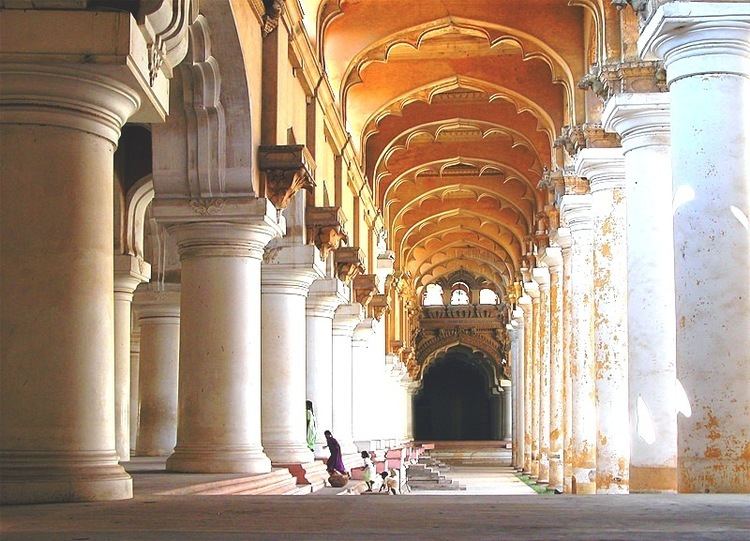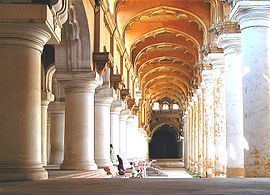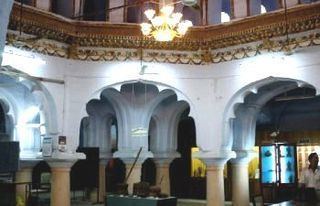Reign 1662– 1682C.E. Name Chokkanatha Nayak Father Muttu Alkadri Nayak Spouse Mangammal | House Madurai Nayaks Died 1682, Madurai Predecessor Muttu Alkadri Nayak Role Ruler | |
 | ||
Successor Rangakrishna Muthu Virappa Nayak People also search for Mangammal, Viswanatha Nayak, Meenakshi, Thirumalai Nayak, Tupakula Lingama Nayaka | ||
Chokkanatha Nayak (1662—1682) succeeded his father Muttu Alkadri Nayak,as the ruler of the Madurai Nayak dynasty, when he was sixteen years old. This young ruler began his reign with an ill-considered attempt to drive out the Muslim troops, despatching a large army against the Gingee fortress. His general, however, sold himself to the enemy and wasted time and money in a long and unprofitable campaign which was little but pretence. Chokkanatha was also harassed by a domestic conspiracy, in which the same unfaithful general took a prominent part, and though he detected and quashed this, the general went over openly to the Muslims and induced them to join in an assault upon Trichinopoly, in which they had the countenance, if not the practical assistance, of the Nayakkan (Nayak ruler) of Tanjore. The officers whom Chokkanatha entrusted with the duty of repelling the attack again were disloyal, and it was not until he himself finally took command of the army that the Muslim invaders were driven back to Tanjore and eventually to Gingee.
Contents
- Conquest and loss of Tanjore
- Attacked by Mysore and the Marathas
- The Marathas seize his country
- References

So far things had not gone so badly, but in the next or the following year (1663 or 1664) Chokkanatha paid a heavy price for his temporary success. The Muslims burst into the Trichinopoly and Madura districts and devastated the country with almost incredible cruelty. They again besieged Trichinoploy, and this time Chokkanatha had to buy them off with a large sum. He consoled himself by punishing the Nayakkan of Tanjore for assisting them, and he attempted similar reprisals on the Setupati of Ramnad, who had failed to help him in repelling them. This latter enterprise was unsuccessful, for though Chokkanatha succeeded in taking several forts in the Marava country, he was baffled by the guerilla tactics of his adversary, and had to retire without obtaining that chief’s submission. This Campaign aspired the Setupati to form a new kingdom.

Conquest and loss of Tanjore
Chokkantha’s next war was with Tanjore, and it resulted in the capture of that ancient city and the extinction of its Nayakka dynasty, the Vijaya Raghava NayakTanjore Nayaks.
The reason for war was the refusal of the Tanjore Nayak to give his beautiful and gifted daughter in marriage to Chokkanatha. The latter determined to fetch the maiden by force back into their capital, and successfully stormed that place. But they did not get the princess; her eualyye determined father Vijaya Raghava Nayak placed her and all the other ladies of the palace in one room, blew this up with gunpowder and then, with his son and his body-guard, charged furiously into the thickest of the enemy, was captured after a desperate resistance, and was beheaded.
Chokkanatha suffered emotionally from the death of his lovely maiden princess, who was his perfect match in brains and beauty. He established a secret love affair with her until the king discovered it through a maidservant who betrayed her trust. Then the tragedy ensued. He could not concentrate on the administration duties and was frequenting the Meenakshi Temple of Madurai to feel the presence of his soul maiden whose ash was strewn in the waters of the holy temple after her death.
Chokkanatha placed his foster-brother Alagiri in charge of the government of Tanjore, but within a year the latter threw off his allegiance, and Chokkanatha was now so given up to self-indulgence and so ill-served by his disloyal officers that, after an outburst of indignation which ended in nothing, he was forced to recognise the independence of Tanjore. Chokkanatha ignored his kingdom as he drowned in thoughts of his deceased lover.
Alagiri, however, was not long permitted to enjoy his ill-gotten kingdom. Chengamala Dasu,a son of the last Tanjore Nayak had escaped to the Muslim court of Bijapur and had induced that power to help to place him on the throne of his fathers. In 1674 the sultan of Bijapur sent a force commanded by the Maratha general Venkaji (alias Ekohji) to turn out the Madura usurper and reinstate the scion of the old line. Venkaji ventured little until the occurrence of the rupture between Chokkanatha and Alagiri; but he then defeated the latter with ease, and occupied Tanjore. He did not, however, place his protégé on the throne, thought he treated him kindly enough, but seized the kingdom for himself. So the outcome of Chokkanatha’s feebleness was that a Maratha, instead of Nayakkan, sat upon the throne of Tanjore.
Venkaji shortly afterwards became embroiled with his famous half-brother Sivaji, and Chokkanatha attempted to take advantage of the circumstance to regain his hold on Tanjore. But he was dilatory in the field and in his negotiations, and Venkaji succeeded in buying off the hostility of Santoji (the son of Sivaji, whom the latter had despatched against him) before Chokkanatha could effect anything. This was in 1677–1678.
Attacked by Mysore and the Marathas
Soon afterwards, Chokkanatha was forced to turn from aggression to the defence of his own kingdom. The famous Chikka Deva Raya, king of Mysore from 1672 to 1704, had for some time been massing troops on his frontier, and now burst upon Coimbatore and spread havoc far and wide. Chokkantha did little to repel him, the country was moreover visited with famine and pestilence, and in despair the ministers of the State deposed their incompetent ruler in favour of his brother.
The change was not for the better, and the perilous state of Madura and its territories in 1678 may be gathered from the following passage in a letter written by one of the Jesuit missionaries in that year:
"The capital, formerly so flourishing, is no longer recognizable, Its palaces, once so gorgeous and majestic, are deserted and falling to ruin. Madura resembles less a town than a brigand’s haunt. The new Nayakkan is essentially a do-nothing king. He sleeps all nights, he sleeps all days; and his neighbours, who do not sleep, snatch from him each moment some fragment of his territories. Nations who would profit from a change of rulers do not trouble to repel invaders and everything foretells that this kingdom, so powerful twenty years back, will soon be the prey of its enemies, or rather the victim of the insane policy of its own government."<citation needed>Chokkantha was replaced on his tottering throne about 1678 by a Muslim adventurer who during the next two years usurped the whole of his authority, and even the ladies of his and his fallen brother’s harems, and at last was slain by Chokkanatha himself and a few of his friends. But Chokkantha’s position still was far from enviable. In 1682 his capital was besieged by Mysore; was shadowed by forces belonging to the Marathas, who, while pretending to be on his side, were only waiting for a chance to seize his territory for themselves; and was threatened by a body of Maravans who norminally and hurried to his assistance, but in reality had only come to share in the booty which the sack of Trichinopoly was expected to yield.
The Marathas seize his country
While Chokkanatha thus sat helpless behind his defences, matters were taken out of his hands by the more virile actors upon this curious scene. The Marathas, who were now established in Gingee as well as Tanjore, inflicted a crushing defeat on the Mysore troops and drove them out of almost every corner of the Madura and Trichinopoly districts. Madura itself they were unable to capture, for the Maravans, regarding the men of Mysore as on the whole more eligible neighbours than the Marathas, helped the former to hold that fortress. The latter had pretended to be, and laid siege to Trichinopoly itself. In despair at their treachery, Chokkantha died of a broken heart in 1682.
